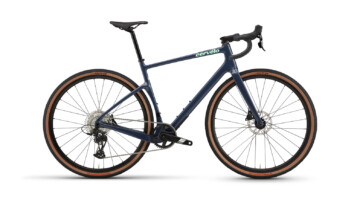by Zach Peters
Riders competing in the Canadian Cyclocross Championships in Winnipeg on October 25 will face extreme obstacles on the course at The Forks. Obstacles make races harder, but they have other uses, and a rich history in the sport.
“I believe there used to be a phrase in the UCI rulebook: ‘Cyclocross shall not require feats of gymnastics,’” notes Brook Watts, race director of CrossVegas.
Obstacles like stairs, run-ups, and barriers do force riders to dismount, which can be tricky on mud or ice. However, flyovers – structures typically constructed of wood – probably emerged not to test athletes’ skills but to direct people around courses.
Watts thinks flyovers originated in Europe, where they’re called bridges. “Of course this is a broad generalization, but Europeans are much more practical than we are. How do I get 20,000 people into this area with the brats and beer concessions without having to pass them five at a time through a crosswalk on the race course? Well, let’s create an elevated flyover or bridge.”
At CrossVegas, Watts also employs flyovers to create spectacle or spectator interest and allow the course to cross over itself. He notices the contraptions on more courses, even at smaller local races.
Probably the first North American flyover appeared in 2005 near Seattle, at StarCrossed. That event’s race director, Terry Buchanan, says it was introduced to add spectacle, spice-up a flat location, and improve spectator access to the venue entrance and beer garden.
While Americans have thus adopted the practical application of obstacles, at least one Canadian organizer pursues innovative creations. The Shimano Canadian Cyclocross Championships is designing a flyover for the 2015 edition. It’s made from digital laser-cut plywood polygons pieced together in the shape of a hill.
In a broader sense, the growing popularity of flyovers signals change in the maturity of North American cyclocross.
Normon Thibault is series race director for Cross on the Rock, a cyclocross series on Vancouver Island with a reputation for difficulty. The DNF rate at one recent race measured almost 15 percent.
Molly Hurford says larger UCI event courses especially have evolved from simple to more complex and challenging. Hurford, a writer at Bicycling Magazine, also authored the book Saddle, Sore: A Women Only Guide to You and Your Bike and has raced for seven years.
“The face of cyclocross is really changing. Promoters want to bring that pro element and bring out spectators more. The participant [recreational] side is already doing really well; the fields are quite full in a lot of the bigger US races,” Hurford says. “Now we just need to up the ante on the pro field.”
She says promoters are building harder courses to grow the pro field and help those riders groom the skills to perform on tougher European tracks. “That’s when you get into adding things like these crazy flyovers, wacky run-ups and drop-offs, different kinds of barriers and obstacles.”
Hurford cites the KMC Cyclo-Cross Festival in Providence, Rhode Island as an example, describing the venue as a flat open park four years ago. This year riders tackled three flyovers, two stair sets, and barriers. UCI rules permit “no more than six man made obstacles.”
Today’s obstacles pale in difficulty compared to those from pre-UCI rulebook days. Early in the 1900’s, courses directed riders over creeks. They would throw the bikes to the opposite bank and then wade across.
This year’s Canadian championship course and the Manitoba Grand Prix of Cyclocross in Winnipeg throw a steep run-up dubbed the “Abyss” and back-to-back sand sections at the riders. The run-up is a 12 meter high wall that rises up from a river. Event co-chair Chris Huebner compares it to the Heusden-Zolder course in Belgium where some riders grab course marker poles to scale the run-up.
The deep, 46 meter long sand pits loom next. A popular location for spectating, they are adjacent to the beer garden.
Cross on the Rock course designers have been adding man-made obstacles and taking advantage of natural features like fallen trees and hillsides to augment course difficulty. “We’re trying to give a full range of types of courses and terrain and obstacles,” Thibault says, “so that somebody who races our series for a couple of years can race pretty much anything in the world.
“We just want to have races where people come and say, ‘That was hard, but man I had a good time.’ We always have ride-arounds whenever there is something extremely difficult. Choose your own adventure lines, we call them.”
According to Watts, there’s talk about creating A and B lines in cyclocross, similar to the alternate routes that are becoming more common in mountain biking. The A line, direct and riskier, saves seconds over the safer B line. “I’m strictly against it – or, until I see others doing it internationally, you will not see an A line and B line in one of my courses,” Watts says. “I’m not quite ready to take cyclocross to that point.”
Thibault says obstacle use in Canada varies by region. In Manitoba where it’s flat, race organizers look for venues with unusual existing features. DarkCross utilizes the grandstand at Red River Co-op Speedway. Racers run up steps between bleacher sections, nose-to-nose with cowbell shaking spectators. Local non-UCI events like DarkCross can have more leeway in utilizing obstacles.
One natural feature shows up everywhere: the weather. Rain or snow can transform a run-up into a test of perseverance as riders take two steps up only to slide back three. But as Hurford points out, that’s what racers sign up for.
“At its heart, cyclocross is what you do when the weather sucks too much to ride on the road or single track. The sport is based on how bad the weather can be and how tough you are and how much you can get through.”
About the Shimano Canadian Cyclocross Championships
The Shimano Canadian Cyclocross Championships is a three-day cyclocross festival taking place October 24 to 26, 2014 at The Forks in Winnipeg, Manitoba. The weekend’s marquee event is the Canadian Cyclocross Championships on Saturday, October 25. Racing continues on Sunday with the Manitoba Grand Prix of Cyclocross, an international UCI C2 race open to professional and amateur athletes. The Kick Cancer Cyclocross Derby launches the weekend on October 24 with a series of fun races and educational opportunities for riders of all abilities to benefit the Cancer Care Manitoba Foundation. Winnipeg welcomes the festival again in 2015 with continued support from title sponsor Shimano. Find more information at http://winnipegcx2014.ca/.




























